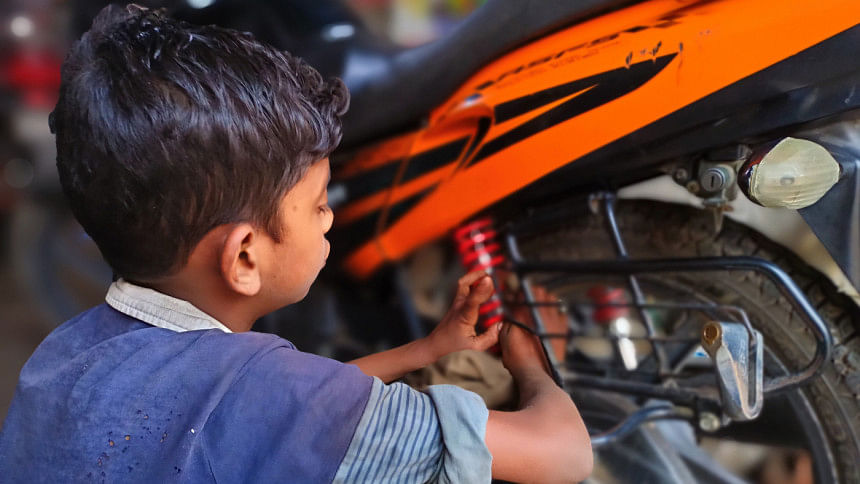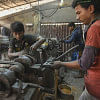Lost childhood, wasted potential: We must put an end to child labour

Child labour remains a persistent issue in Bangladesh, as evidenced by the recent National Child Labour Survey-2022, which reveals a concerning rise of 4.5 percent in child labour over the past decade. Many children have dreams and aspirations of what they want to become in the future. However, child labour drastically limits their possibilities and crushes these dreams, as they are forced to accept their current circumstances instead of working towards a brighter future.
The harsh reality is that, over 17.76 lakh children (or approximately 8.90 percent) aged 5-17 years are victims of child labour in the country, according to the survey conducted by Bangladesh Bureau of Statistics (BBS). This alarming increase calls for immediate action and a united effort, particularly from the government, NGOs, INGOs, and private companies which have corporate social responsibility funds.
Bangladesh has taken legislative measures to combat child labour through key laws such as the Bangladesh Labour Act 2006 and the Bangladesh National Child Labour Elimination Policy 2010. The latter policy aimed to eradicate hazardous child labour from the country by 2015, aligning with the Millennium Development Goal. However, the aforementioned survey's outcomes have exposed the dire reality of our current situation, revealing how far we have fallen behind in achieving our objectives. The enforcement of these laws must be strengthened. For one, the government should allocate sufficient resources to ensure that child labour is strictly prohibited and that violators are brought to justice.
It is commendable that some NGOs and INGOs like Unicef, Caritas Bangladesh's Alokito Shishu Project, and Plan International are wholeheartedly dedicating their work to improving the lives of underprivileged children. But it is imperative that the government take a leading role in coordinating and strategising efforts. By creating a comprehensive plan that aligns with the objectives of all child-focused organisations, the government can ensure that resources are optimally utilised, duplication of efforts is minimised, and a unified approach is adopted in tackling the issue of child labour.
According to the BBS survey, income inequality, economic injustice, and discriminatory social structures are among the root causes driving children into the workforce. These factors deny children the opportunity to receive education, exposing them to exploitation and hazardous work environments. To tackle this crisis comprehensively, all stakeholders must come together to address certain key issues.
Authorities must improve child protection mechanisms, ensuring that child welfare is a top priority.
The government should provide adequate funding, technical support, and monitoring mechanisms to empower organisations to carry out their crucial work efficiently and sustainably. Together, through strong partnerships and a shared vision, these entities can work towards eradicating child labour and creating a safer, healthier, and more promising future for the country's children.
Education is a fundamental right and a powerful tool to break the cycle of poverty and child labour. The government should invest more in the education sector, making quality education accessible to all children, regardless of their socio-economic background. NGOs and INGOs can contribute to this effort by establishing schools in vulnerable areas and providing educational opportunities for underprivileged children.
Many lower-income families resort to child labour due to financial hardships. To address this, the government and private companies should focus on creating employment opportunities and promoting fair wages for adults. Skill development programmes can also empower parents to secure stable jobs and provide better for their families.
Public awareness campaigns can be a powerful tool in highlighting the detrimental effects of child labour on children's physical and mental well-being. By fostering a collective sense of responsibility, society can advocate for the eradication of child labour and create a more supportive environment for children. Private companies with corporate social responsibility funds can use those to invest in community development initiatives, support education programmes, and implement responsible supply chain practices to ensure that their products are free from child labour.
Authorities must improve child protection mechanisms, ensuring that child welfare is a top priority. This involves identifying and rescuing children from hazardous work situations, providing them with rehabilitative services, and monitoring their well-being.
The issue of child labour in Bangladesh is complex and deeply entrenched, but it is not insurmountable. With concerted efforts and a firm commitment to the welfare of children, progress can be made. It is crucial that all entities with the required means and resources step forward and play their part in securing a brighter future for the children of Bangladesh. Let us unite in our resolve to end child labour and ensure that every child can enjoy their childhood, pursue an education, and fulfil the dream of a more promising future.
Rabiul Alam is an independent writer and a graduate of Asian College of Journalism in India.

 For all latest news, follow The Daily Star's Google News channel.
For all latest news, follow The Daily Star's Google News channel. 









Comments